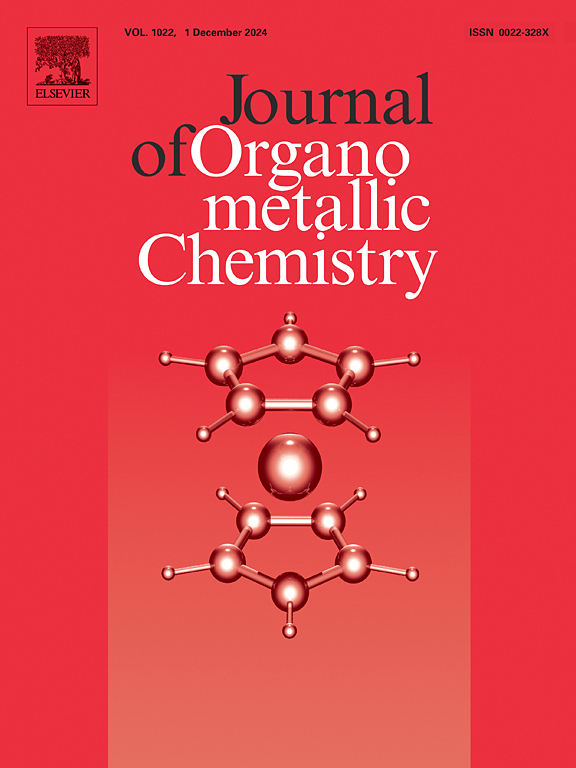近红外吸收二茂铁吩噻嗪基推拉发色团
IF 2.1
3区 化学
Q3 CHEMISTRY, INORGANIC & NUCLEAR
引用次数: 0
摘要
采用pd催化Sonogashira交叉偶联,通过热激活[2 + 2]环加成-电环开环反应,设计并合成了一系列二茂铁官能化吩噻嗪(PTZ) π共轭推拉发色团(PTZ 1-6)。考察了扩展π共轭和电子受体1,1,4,4-四氰丁-1,3-二烯(TCBD)和环己-2,5-二烯-1,4-二芳基-扩展TCBD对PTZ 1 - 6的光物理、电化学和光谱电化学性能的影响,并进行了理论研究。光物理性质表明,与乙炔桥接化合物PTZ1和PTZ2相比,TCBD和DCNQ功能化的PTZ 3-6的紫外-可见光谱发生了色移。电化学分析显示,在低电位范围内,二茂铁和吩噻嗪的给体单元有多个氧化电位波,TCBD和DCNQ受体有多个还原电位波。电化学光谱分析表明,氧化还原过程中形成的氧化还原物质在近红外区(630 ~ 930 nm)有吸收光谱。计算结果表明,DCNQ片段比TCBD单元更有效地稳定了LUMO能级。本文章由计算机程序翻译,如有差异,请以英文原文为准。

NIR absorbing ferrocenyl phenothiazine based push–pull chromophores
A series of ferrocenyl (Fc) functionalized phenothiazine (PTZ) π–conjugated push–pull chromophores (PTZ 1–6), were designed and synthesized using Pd-catalyzed Sonogashira cross–coupling, followed by thermally activated [2 + 2] cycloaddition-electrocyclic ring-opening reaction. The effect of extended π–conjugation and electron acceptors 1,1,4,4-tetracyanobuta-1,3-diene (TCBD) and cyclohexa-2,5-diene-1,4-diylidene-expanded TCBD, on the photophysical, electrochemical, and spectroelectrochemical properties, as well as theoretical study, was examined for PTZ 1–6. The photophysical properties indicate that TCBD and DCNQ functionalized PTZ 3–6 exhibit a bathochromic shift in their UV–vis spectra as compared to the acetylene-bridged compounds PTZ1 and PTZ2. The electrochemical analysis revealed multiple oxidation potential waves attributed to the donor units (ferrocene and phenothiazine), as well as reduction waves corresponding to the TCBD and DCNQ acceptors, observed at a low potential range. The spectroelectrochemical analysis indicates that the redox species formed during the redox cycles showed absorption spectra in the NIR region (630–930 nm). The computational calculations suggest that the DCNQ moiety stabilizes LUMO energy levels more effectively than the TCBD unit.
求助全文
通过发布文献求助,成功后即可免费获取论文全文。
去求助
来源期刊

Journal of Organometallic Chemistry
化学-无机化学与核化学
CiteScore
4.40
自引率
8.70%
发文量
221
审稿时长
36 days
期刊介绍:
The Journal of Organometallic Chemistry targets original papers dealing with theoretical aspects, structural chemistry, synthesis, physical and chemical properties (including reaction mechanisms), and practical applications of organometallic compounds.
Organometallic compounds are defined as compounds that contain metal - carbon bonds. The term metal includes all alkali and alkaline earth metals, all transition metals and the lanthanides and actinides in the Periodic Table. Metalloids including the elements in Group 13 and the heavier members of the Groups 14 - 16 are also included. The term chemistry includes syntheses, characterizations and reaction chemistry of all such compounds. Research reports based on use of organometallic complexes in bioorganometallic chemistry, medicine, material sciences, homogeneous catalysis and energy conversion are also welcome.
The scope of the journal has been enlarged to encompass important research on organometallic complexes in bioorganometallic chemistry and material sciences, and of heavier main group elements in organometallic chemistry. The journal also publishes review articles, short communications and notes.
 求助内容:
求助内容: 应助结果提醒方式:
应助结果提醒方式:


